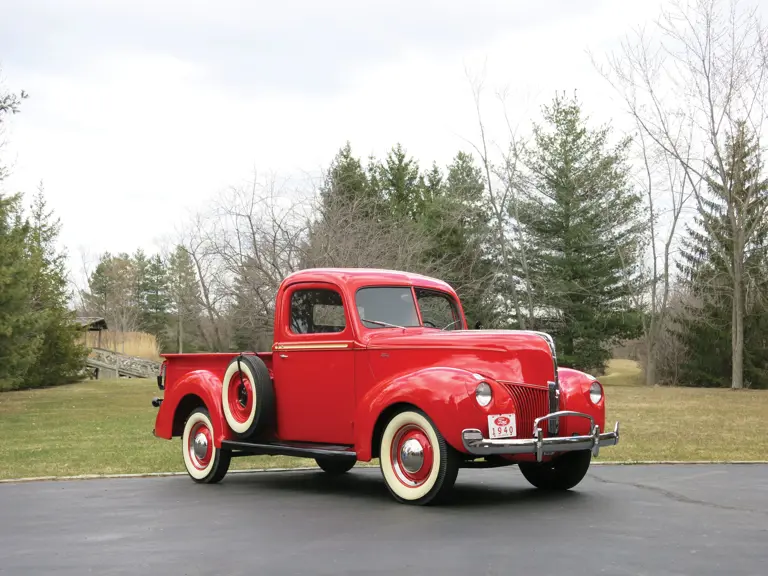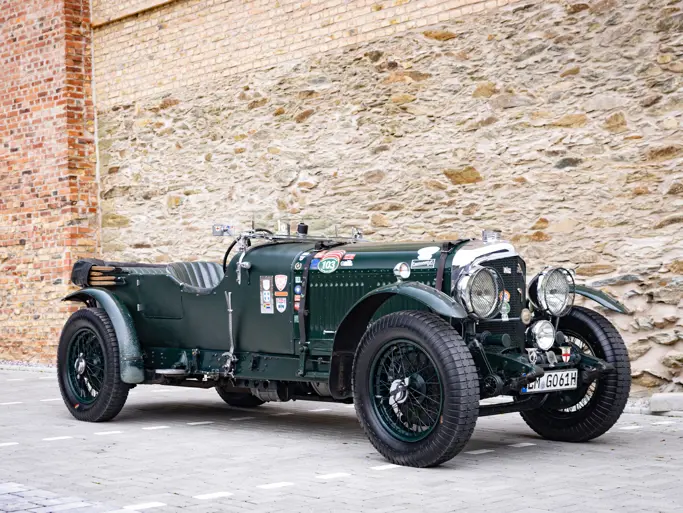The first production, small size, Ford pickup truck was built in 1925 by taking the rear trunk assembly off of a Model T roadster and replacing it with a pickup bed. The small size pickup became an instant success and continued to be produced until Model T production ended in 1927. With the introduction of the new Model A Ford in 1928, Ford offered the small size pickup with an open driver’s area and an enclosed driver’s compartment. This would continue with the introduction of the new Ford V-8 in 1932. By 1935, Ford only built the pickup truck with an enclosed cab and by this time Ford was the leading producer of small size commercial vehicles with Chevrolet following a close second. By the late 1930s, the Ford pickups began to have a distinctive design of their own and no longer looked like modified passenger vehicles.
Ford's chief designer E.T. "Bob" Gregorie gave the all-new 1940 light-duty trucks the crisp, clean "prow front" styling of the 1939-1940 passenger cars, and this popular design carried over to the 1941 Ford truck line. As fresh and distinctive as on the cars, that look has stood the test of time beautifully.
Behind the new face of the 1940-1941 Ford half-ton pickup was a host of mechanical improvements. Cabs were sturdier and wider, and windshields were fixed with cowl-mounted wipers. Sealed-beam headlamps were new, and mattress-type springs offered extra passenger comfort. The smart rectangular instrument cluster also resembled that of Ford cars. Underneath, light-duty trucks retained what amounted to a Ford car frame: a double-drop design with X-member bracing, stamped from heavier 10-gauge steel instead of 11-gauge. Suspension was still by transverse leaf springs front and rear, which dated from Model T days, plus lever shocks and, on some models, a front stabilizer bar.
The handsome new styling of the 1940 Ford half-ton pickup was a big asset against rival Chevy's carryover fleet in 1940, but Chevrolet's redesigned AK-series for 1941 was more formidable. Ford countered with minor trim changes, deciding there was no reason for wholesale revision of Gregorie's excellent design.
The standard engine for the 1940 and 1941 pickups was Ford's 221-cid flathead V-8 with 85 horsepower; though a Mercury 239 with 95 horsepower and the small Ford V-8/60 were optional. In mid-season, the V-8/60 was replaced by a 120-cid four-cylinder engine from the Ford 9N tractor - a curious choice, and not very popular. Rarely seen and less desirable was the passenger car's inline six, a late-season no-cost option available for pickup truck buyers.
Ford’s light-duty truck options for 1940 included the pickup truck, which could be offered with a standard bed, a flat bed with removable stakes, or could be sold without a bed so the buyer could build one to suit his needs. In addition to the pickup truck Ford also offered a sedan delivery and a small size panel truck. These light-duty vehicles were built on a modified version of the standard passenger car chassis and used the same engine options that were available to passenger car buyers.
This 1940 Ford pickup is an extremely well-presented restoration. It was chosen by Ford Motor Company in 2003 to be part of a Centennial Celebration display and was exhibited at the Ford Dealership Convention at the Greenbrier Resort in White Sulphur Springs, Virginia.
Today, this pickup remains in excellent condition. Upon close inspection, it appears that this pickup was always a solid and well-cared-for truck that did not suffer the typical abuses that pickup trucks normally encounter. Underneath, the frame shows no evidence of damage or repair. The lower body sills and the pickup bed sub-frame are in excellent condition and do not appear to have been repaired. On the exterior, the pickup bed is nice and straight with undamaged flare sides. The interior of the bed has been restored with the proper wood flooring and bed strips. The cab is also in excellent condition. The doors fit the cab well and the hood aligns properly with the cab and fenders. All four fenders are in excellent condition and do not look like they have been repaired.
The red paint is in excellent condition. The paint has an overall even gloss and shows hardly any signs of wear or discoloration.
The simple black interior is in excellent condition. The seats have been recovered in a period correct vinyl material and show hardly any signs of wear. The dashboard has been properly restored with correct gauges and controls. All of the window glass has been replaced and is in excellent condition.
The engine bay houses the popular 221-cid, 85-hp flathead V-8 engine and this compartment is extremely clean and nicely detailed. The engine has its correct carburetor, air cleaner and distributor ignition system. The firewall and inner fenders have been properly restored and are in very good condition. The chassis is in similar condition. It appears that this truck was given a frame-off restoration and today the chassis is very clean and presentable. The original 16-inch steel wheels have been properly restored and have nearly new tires. Additional equipment includes a side-mounted spare, chrome bumpers front and rear, cabin heater, whitewall tires and dual taillights.
Overall, this is an excellent example of one of the most desirable, prewar Ford pickups. It has been well-restored and well-cared-for and is in excellent condition inside and out.



 | Auburn, Indiana
| Auburn, Indiana


